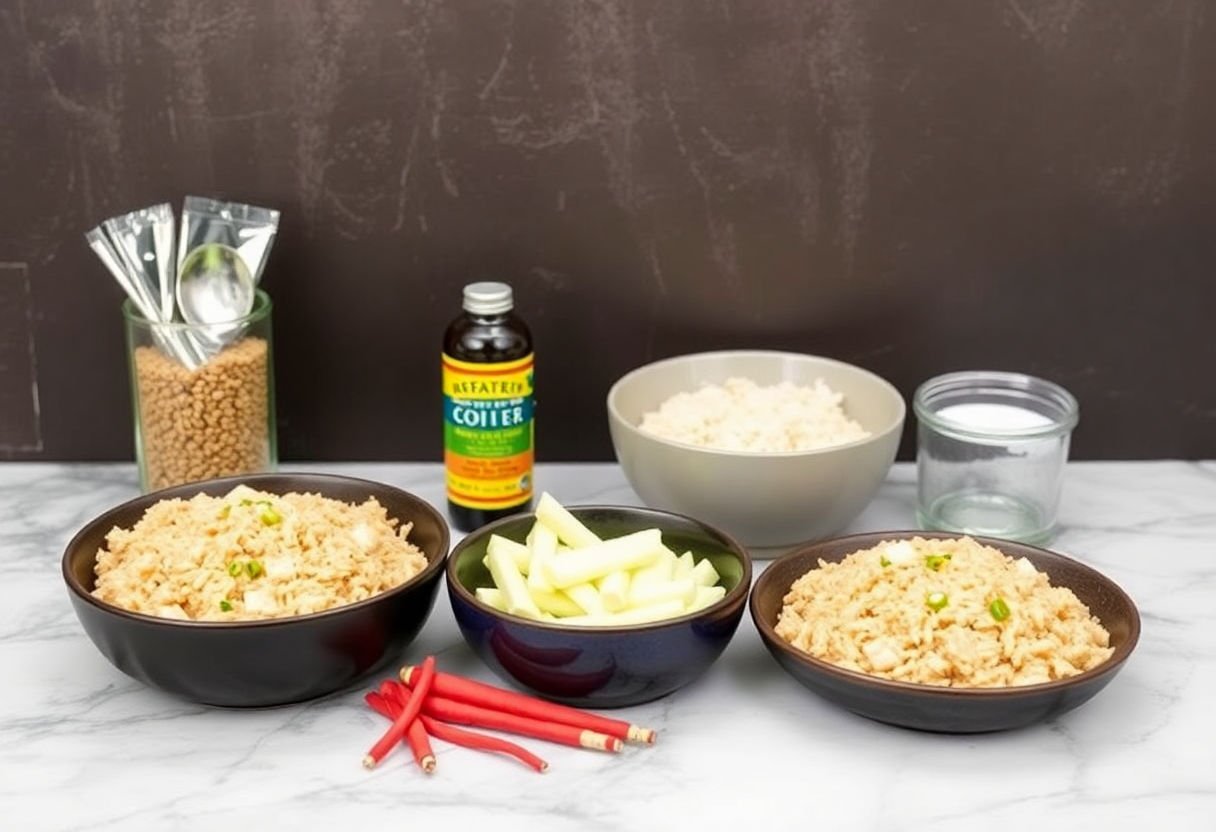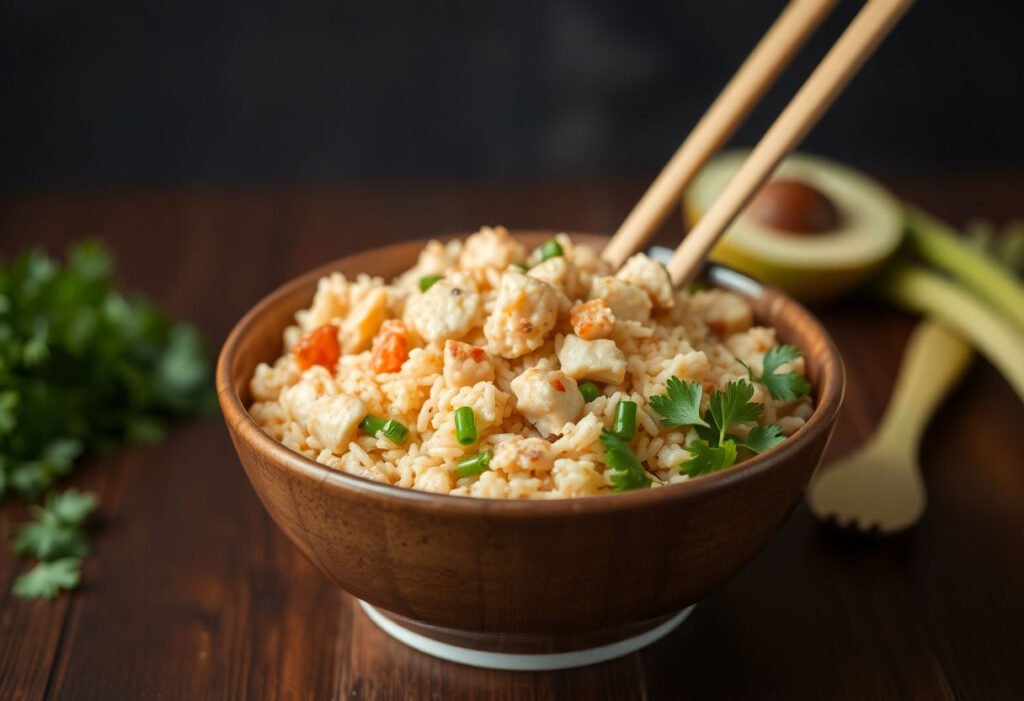Chicken fried rice meal prep offers an elegant solution for streamlining your weeknight dinners, providing not only convenience but also delicious, satisfying meals. With a focus on efficiency and taste, this culinary approach embraces the art of meal prepping to ease weekday culinary burdens. By incorporating essential ingredients and showcasing straightforward cooking methods, the goal is to prepare several meals in advance, ensuring they are both nutritious and flavorful. As you explore this article, discover time-saving tools, budget-friendly strategies, and customization tips tailored to diverse dietary needs, guiding you towards a more organized and enjoyable dining experience each evening.
Key Takeaways
- Chicken fried rice meal prep provides a convenient and efficient solution for busy weeknight dinners, ensuring delicious meals with minimal effort.
- Meal prepping enhances your weekday dining experience by saving time, reducing stress, and simplifying kitchen routines.
- Essential ingredients such as chicken, rice, and vegetables are key to creating a flavorful and satisfying dish suitable for multiple meals.
- Proper storage and reheating techniques are crucial in maintaining the quality, taste, and safety of your prepped meals.
- Customizing chicken fried rice allows flexibility to cater to diverse dietary preferences and nutritional needs, making it a versatile choice for any household.
Benefits of Meal Prepping
Meal prepping has become increasingly popular due to its numerous advantages, which are especially beneficial for easing the hustle of weeknight dinners. One of the primary benefits of meal prepping is the significant time savings it offers. By dedicating a few hours to prepare meals in advance, you ensure that healthy and delicious options are ready to eat in minutes during busy evenings.
Moreover, meal prepping encourages healthier eating habits. When meals are planned and prepared ahead of time, you are less likely to opt for unhealthy takeout or fast food due to convenience or time constraints. This practice allows you to control the ingredients and portions, leading to more balanced and nutritious meals.
Financial savings are another compelling reason to engage in meal prepping. By purchasing ingredients in bulk and preparing them at once, you reduce food waste and grocery costs. This is not only economical but also environmentally friendly, contributing to a sustainable lifestyle.
Additionally, meal prepping provides the opportunity to ensure variety and consistency in your diet. Planning your meals allows you to incorporate a range of ingredients and flavors, avoiding the monotony of eating the same dishes repeatedly. This is particularly relevant with dishes like chicken fried rice, which can be enhanced with different vegetables and seasonings.
Lastly, meal prepping fosters mindfulness and stress reduction in your daily routine. Knowing that your meals are already prepared diminishes the everyday decision-making load, allowing you to focus on other important tasks and reducing the stress commonly associated with meal preparation after a long day.
Essential Ingredients for Chicken Fried Rice
To craft a delightful chicken fried rice, a selection of essential ingredients is paramount, each adding unique flavors and textures to this beloved dish. At the heart of this meal is the chicken, which provides a rich source of protein, making the dish both hearty and filling. Opt for boneless, skinless chicken breasts or thighs, as they offer flexibility and ease of preparation.
Rice forms the foundation of this dish, with cold, day-old jasmine or long-grain rice being ideal for achieving the perfect texture. Freshly cooked rice tends to clump, whereas older rice ensures each grain is distinctly separate, contributing to the satisfying mouthfeel characteristic of well-executed fried rice.
Adding vegetables not only enhances the nutritional value but also infuses vibrant colors and varied textures. Common choices include peas, carrots, and bell peppers, balancing the dish with sweetness and freshness. You may also add corn or green beans for additional variety.
Aromatics like garlic and onion are indispensable, as they provide a depth of flavor that forms the dish’s aromatic base. For those who enjoy a hint of spice, the inclusion of fresh ginger or a dash of red pepper flakes can elevate the dish’s flavor profile.
To tie all these elements together, a few tablespoons of soy sauce impart a savory umami complexity that’s both pleasing and familiar. You might also consider a splash of sesame oil or oyster sauce for an extra layer of rich flavor.
For a final touch, don’t forget eggs, which, when scrambled within the rice, add richness and contribute to the traditional taste and texture. Garnishing with scallions enhances the dish with a fresh, crisp flavor, while sesame seeds can offer a subtle nutty note.
These foundational ingredients are critical for transforming a simple meal prep into a culinary delight, ensuring your weeknight dinners are both efficient and exquisite.
Step-by-Step Meal Prep Guide

Embarking on the chicken fried rice meal prep journey is a strategic way to save time while guaranteeing delicious weeknight dinners. Follow these steps to ensure success in your meal preparation:
-
Plan Your Portions: Determine how many meals you plan to prepare, taking into account your household size. Aim for balanced portions, typically measuring one cup of cooked rice and half a cup of chicken per serving.
-
Cook the Rice: Begin by cooking your rice. Choosing long-grain rice or jasmine rice ensures a fluffy texture. Once cooked, spread it on a baking sheet to cool, preventing clumping and retaining the ideal consistency.
-
Prepare the Chicken: Opt for boneless, skinless chicken breasts or thighs for ease of preparation. Season generously with salt, pepper, and your choice of spices. Sauté the chicken in a hot pan with minimal oil until golden brown and cooked through.
-
Assemble Vegetables: Incorporate a variety of vegetables for added nutrition and color. Common choices include peas, carrots, and bell peppers. Dice them uniformly to promote even cooking.
-
Stir-Fry Time: Use a large wok or skillet for combining ingredients. Start by scrambling eggs lightly in the pan, followed by cooking vegetables until crisp-tender. Introduce the cooled rice, chicken, and a dash of soy sauce, stirring everything together for a cohesive flavor.
-
Portion and Store: Divide the chicken fried rice into airtight containers for reliable storage. Allow the food to cool completely before sealing to maintain freshness.
By following these steps, meal prepping for chicken fried rice becomes an efficient and rewarding task, delivering savory and balanced meals with minimal daily hassle.
Storage and Reheating Tips
Storing and reheating your chicken fried rice properly is crucial to maintaining its flavor and quality throughout the week. For optimal storage, allow the cooked fried rice to cool slightly before transferring it to airtight containers. This step prevents condensation, which can lead to soggy rice. Make sure to divide the rice into individual portions, as this helps in maintaining freshness and eases the reheating process. When stored in the refrigerator, your meal-prepped chicken fried rice can last up to four days.
For longer storage, consider freezing your portions. To do this effectively, place the rice in freezer-safe containers or resealable freezer bags, removing as much air as possible to prevent freezer burn. Label each container with the date to keep track of storage time, and consume within one to two months for best taste.
When it comes to reheating your chicken fried rice, it’s important to preserve its texture and avoid drying it out. The microwave offers a quick solution: simply place the rice in a microwave-safe dish, sprinkle it with a tablespoon of water or broth to add moisture, and cover loosely with a damp paper towel. Heat on medium power, stirring halfway through, until thoroughly warmed. Alternatively, use a skillet on medium heat, adding a splash of oil or water as needed, and sauté the rice until hot, occasionally stirring to ensure even heating.
By following these storage and reheating tips, you can enjoy your meal-prepped chicken fried rice just as much as when it was freshly made, ensuring delicious and convenient dinners throughout the week.
Customizing Your Chicken Fried Rice

Embracing the versatility of chicken fried rice allows you to adjust flavors and ingredients to match your personal preferences or dietary needs. By using a range of add-ins and substitutions, you can transform this dish into a culinary masterpiece that caters to your taste.
Increase Protein Content: For those seeking a higher protein meal, consider adding more chicken or incorporating different types of meat such as shrimp or tofu. Each of these options contributes its unique texture and flavor, enhancing the dish’s nutritional profile.
Vegetable Variations: Veggies are an excellent way to infuse color and nutrients into your meal. Feel free to experiment with bell peppers, carrots, or snap peas. If you prefer an earthy taste, mushrooms or broccoli are wonderful choices.
Spice and Flavor Adjustments: Customize the heat level by incorporating fresh chilies, red pepper flakes, or a dash of sriracha. For a hint of sweetness, add some pineapple chunks or a drizzle of honey.
Grain Alternatives: If you’re following a specific diet, consider substituting white rice with brown rice, cauliflower rice, or quinoa. These alternatives provide a different texture and increase the health benefits of your dish.
Sauce Variations: While traditional soy sauce is a staple, tamari can be used for a gluten-free option, or coconut aminos for a lower-sodium substitute.
Customization is key—let your preferences guide you to a tailor-made chicken fried rice that doesn’t just fit into your meal prep routine but transforms it into a delightful culinary journey.
Balancing Nutrition in Your Meals

Balancing nutrition in your chicken fried rice meals requires mindful consideration of ingredients to ensure a wholesome dish that satisfies dietary needs. A harmonious meal should incorporate essential macronutrients—proteins, carbohydrates, and fats—alongside micronutrients vital for maintaining overall health.
Proteins play a crucial role in muscle repair and immune function. Including lean chicken provides a high-quality source of protein, helping to keep you satiated longer. Alternatively, consider incorporating tofu or edamame for a plant-based protein boost, suitable for vegetarian diets.
Carbohydrates are the primary energy source, and rice serves as a staple in chicken fried rice. Opt for brown rice as it contains more fiber and nutrients compared to white rice, supporting digestive health and offering sustained energy release. Incorporating a variety of vegetables, such as broccoli, bell peppers, or carrots, not only enriches the dish with vitamins and minerals but also adds vibrant color and texture.
Healthy fats can enhance the dish’s satiety and flavor. Using a moderate amount of olive oil or sesame oil contributes to heart health and imparts a delightful aroma.
To ensure nutritional equilibrium, consider the following strategies:
- Portion Control: Balance grain-to-vegetable ratios to lower calorie density while increasing nutrient intake.
- Seasoning: Use herbs and spices instead of excessive salt or sauces to enhance flavor without compromising health.
Mindfully prepared, meal-prepped chicken fried rice can be a nutritious fixture in your weeknight routine, bringing convenience and health to your dining table.
Time-Saving Kitchen Tools
Incorporating time-saving kitchen tools into your meal prep routine can significantly enhance the efficiency of your chicken fried rice preparation, making weeknight dinners a breeze. Here are some essential tools that will streamline your cooking process:
-
Rice Cooker: This indispensable appliance not only cooks rice perfectly but also keeps it warm until you’re ready to use it. It eliminates the need for constant supervision, freeing up time to focus on other meal prep tasks.
-
Food Processor: A high-quality food processor can chop, slice, and dice your vegetables swiftly and uniformly. This reduces the manual labor involved in knife work, ensuring consistent piece sizes for even cooking in the fried rice.
-
Non-Stick Wok or Skillet: Utilizing a non-stick wok or skillet allows for quick and even cooking of chicken and vegetables. The non-stick surface ensures minimal oil usage and easy cleanup, making it an eco-friendly and health-conscious choice.
-
Multi-Purpose Mixing Bowl Set: Investing in a set of mixing bowls with lids can facilitate easy mixing, storing, and marinating of ingredients. Opt for stackable varieties to save space in the kitchen.
-
Silicone Spatulas: These versatile tools assist in stirring and folding ingredients without scratching non-stick surfaces. They are heat-resistant and flexible, making them ideal for sautéing components seamlessly.
By integrating these tools into your kitchen, the process of prepping chicken fried rice becomes not only more efficient but also more enjoyable, allowing you to maintain a swift workflow while ensuring delicious results.
Budget-Friendly Meal Prep Tips

To achieve a cost-effective chicken fried rice meal prep, begin by purchasing ingredients in bulk. Rice, chicken, and frozen vegetables are often cheaper when bought in larger quantities, enabling you to save on both money and time. In particular, opt for long-grain rice and frozen mixed vegetables, as these can maintain their quality over an extended period.
Focus on using versatile ingredients. For instance, chicken thighs are typically more affordable than breasts and provide a richer flavor. Substitute fresh vegetables with frozen ones to reduce costs without sacrificing nutritional value. Additionally, frequent farmers’ markets or local produce stands can offer seasonal vegetables at competitive prices.
Maximize savings by incorporating leftover ingredients from other meals. Leftover chicken or vegetables can easily be integrated into the chicken fried rice, enhancing both flavor and reducing waste. Value can also be found in pantry staples: soy sauce, sesame oil, and fresh garlic are long-lasting and integral to the dish’s flavor profile.
Consider preparing meals that can be easily adjusted for portion sizes. Bulk cooking allows for better control over portion distribution and efficient meal planning for the week. You may find it helpful to allocate meals into individual containers, ensuring portion uniformity and reducing food waste.
Finally, utilize simple yet effective meal-prepping tools such as a rice cooker or an electric skillet. These appliances can accelerate the cooking process and ensure consistency, ultimately making meal prep both affordable and enjoyable. By implementing these strategies, chicken fried rice becomes not only a nutritious choice but an economically sound option for weeknight dinners.
Conclusion
Incorporating chicken fried rice meal prep into your weekly routine transforms the often hectic dining schedule into an organized and efficient process. By leveraging simple and customizable recipes, this approach not only saves time but also enhances nutritional balance and cost-effectiveness. As you continue to streamline your meal planning, consider experimenting with diverse ingredients to keep your meals enjoyable and catering to varying dietary needs. Embracing meal prepping promises sustained convenience and flavor, ultimately fostering a more relaxed and enjoyable evening routine, free from the usual culinary stress.
Frequently Asked Questions
How long does prepared chicken fried rice last in the refrigerator?
Prepared chicken fried rice can be stored in airtight containers in the refrigerator for up to 4 days. It is important to reheat it thoroughly before consuming to ensure food safety.
Can I freeze chicken fried rice for longer storage?
Yes, chicken fried rice can be frozen for up to 3 months. Ensure it is stored in freezer-safe containers or bags, and defrost it in the refrigerator before reheating.
How can I make chicken fried rice more nutritious?
To enhance the nutritional value, incorporate a variety of vegetables such as bell peppers, peas, and carrots. Using brown rice instead of white rice can also increase fiber content.
Are there vegetarian options for chicken fried rice meal prep?
Certainly! You can substitute chicken with tofu or tempeh to create a vegetarian version of fried rice. These alternatives provide similar texture and protein content.
What is the best way to reheat chicken fried rice?
For optimal results, reheat chicken fried rice on the stovetop in a non-stick pan over medium heat. Stir frequently to heat evenly and maintain the meal’s original texture and flavor.


